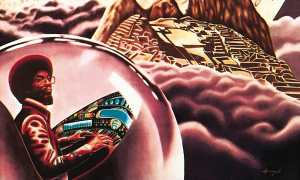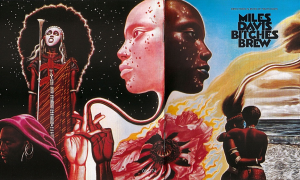Home » Jazz Articles » Rediscovery » Mark Isham: Blue Sun
Mark Isham: Blue Sun
 Mark Isham
Mark IshamBlue Sun
Columbia Records
1995
Better-known, perhaps, for his work in the film arena as scorer for movies including 1986's The Hitcher, the 1992 reboot of Of Mice and Men and 1998's Blade, Mark Isham has, nevertheless, demonstrated his instrumental prowess as a trumpeter on albums including pianist Art Lande's Rubisa Patrol (ECM, 1976), singer/songwriter Van Morrison's Beautiful Vision (Warner Bros., 1982), David Sylvian's Brilliant Trees (Virgin, 1984), David Torn's Cloud About Mercury (ECM, 1987) and singer/songwriter Joni Mitchell's Both Sides Now (Reprise, 2000) But it's on two albums that Isham released in the mid-to-late-'90s where he not only demonstrated his strength as a player, but as a composer of music in the jazz sphere and as a bandleader capable of putting together a real roadworthy group. Both albums are worthy of Rediscovery, but for the sake of sheer surprise, 1995's Blue Sun (Columbia) wins by a nose.
While both Blue Sun and its 1999 followup, Miles Remembered: The Silent Way Project (Columbia), both paid tribute to the importance of trumpet icon Miles Davis, the second album was more aggressively electric, despite some softer, more atmospheric inclusions like Isham's arrangement of the Davis staple, Joe Zawinul's title track to In a Silent Way (Columbia, 1969); and an ethereal look at Davis' classic song from his game-changing Kind of Blue (Columbia, 1958), "All Blues."
Still, Blue Sun is overall a more successful venture if for no other reason than Isham's compositional contributions rendering his subject clear while, at the same time, being devoted to a more original work of music. Miles Remembered does contain some Isham originals, but it's largely predicated on music culled from across Davis' career, ranging from Milestones (Columbia, 1958) through to Bitches Brew (Columbia, 1970), On the Corner (Columbia, 1972) and Big Fun (Columbia, 1974); Blue Sun, on the other hand, is more reflective of Davis' influence through the prism of Isham's own writing and playing, with seven of Blue Sun's nine tracks penned by the trumpeter, and its two other tunes culled from the repertoires of Duke Ellington (a particularly poignant "In a Sentimental Mood") and the writing team of Jerome Moross, John Latouche and Jürg Morgenthaler ("Lazy Afternoon").
The only common element linking Blue Sun to Miles Remembered, alongside Isham's career-defining performances and compositional prowess, is the appearance of bassist Doug Lunn (Brand X, The Deviants) on both sessions. Other than that, the two albums couldn't be more different. Blue Sun is a keyboard-driven affair that, in addition to David Goldblatt's exceptional acoustic and electric piano work, also features Steve Tavaglione as a harmonic and improvisational foil for Isham and drummer Kurt Wortman, another longtime Isham collaborator who, in addition to copious session work, can be found on albums by diverse artists ranging from Art Lande (including Rubisa Patrol, a connection shared with Isham) and Van Morrison (including another Isham intersection, 1979's Into the Music (Warner Bros.)) to Bruce Springsteen and David Torn. The more electrified Miles Remembered, on the other hand, is more decidedly defined by its twin-guitar lineup (Steve Cardenas and Peter Maunu) that, along with Lunn and Isham, is driven to higher energy extremes by drummer Michael Barsimanto (Eddie Jobson, Brand X, Mark O'Connor).
It's great to hear Tavaglione in the largely more acoustic context of Blue Sun; a busy west coast saxophonist, Tavaglione's work has been found as often on fusion-heavy works by the likes of Scott Kinsey (Kinesthetics (Abstract Logix, 2006)), Jing Chi (3D (Tone Center, 2004)) and Weather Report tributes (Mysterious Voyages-A Tribute To Weather Report (ESC, 2005)) as it is soundtracks by Thomas Newman, Lalo Schifrin and, indeed, Mark Isham. Here, however, on tracks like the softly swinging, Phrygian-dominated album opener "Barcelona," Tavaglione demonstrates surprising credibility in a more eminently jazz context, delivering a solo built on a muscular tone, a particularly potent altissimo and a strong sense of compositional focus. Goldblatt, on the other hand, contributes his own feature that's a similar surprise when compared, like Tavaglione, to his more fusion-focused work with Tribal Tech, Alphonse Mouzon and Frank Gambale.
What makes Blue Sun so special is its overall vibe; while occasional tracks like "Trapeze"—where Isham's Harmon mute draws another comparison to Davis, though Isham's tone is not quite as fragile (nor as vulnerable)— elevate the energy and collective power of Isham's quintet, the overall ambience is one of dark-hued brooding and indigo- infused melancholy. Plenty beautiful, for sure; but in a less joyous or optimistic fashion, "Lazy Afternoon" is given a tone poem treatment, while the title track is more decidedly groove-inflected and "In More Than Love" hauntingly tender; all three compositions both different and of a kind...while the contextually simple and eminently singable "And Miles To Go ... Before He Sleeps" opens a window into a brighter world, with Lisbeth Scott's vocal loop (one of three artists contributing loops to the album's overall soundscape) adding an atmospheric cushion.
The album closes on the slightly brighter but still somehow crepuscular note of "Tour de Chance." Like the eight tracks that came before, it's loaded with easy to digest lyricism—in this case bolstered by Goldblatt's relatively rare use of electric piano during the main melody and switching to acoustic piano during Isham's solo (one of the trumpeter's strongest showings of the set), before returning to electric piano for the reiteration of a theme that, in its saxophone/trumpet unison theme and riff-driven groove, might have fit easily onto an album by the late British trumpeter Ian Carr and his seventies-era band Nucleus.
It's a real shame that I missed Isham's Blue Sun's tremendous show at the Festival International de Jazz de Montréal (see below)—waiting, instead, for four years to catch the Miles Remembered group at the same event. As terrific as his twin-guitar, electrified and rock-charged live shows with that album's group were, it would have been terrific to have had the chance to hear where Isham took Blue Sun's music in performance. With a set of nine tunes whose collective atmosphere was redolent of without sounding at all like a Miles Davis tribute, Blue Sun was consequently a more personal homage: one that couldn't have been made without Davis' influence as the younger Isham was coming up but, equally, one that speaks more clearly of Isham's own voice as a composer, performer and bandleader...making it an album absolutely worthy of Rediscovery.
And, with the benefit of Isham's years of studio experience and production acumen—as well as Joe Gastwirt's rich, almost cushiony mastering—Blue Sun is an album that positively sings through a home system comprised of a pair of Tetra 333 speaker stacks, OPPO BDP-105D player and Leema Tucana II integrated amp. Music this good should sound this good.
So, what are your thoughts? Do you know this record, and if so, how do you feel about it?
Tracks: Barcelona; That Beautiful Sadness; Trapeze; Lazy Afternoon; Blue Sun; In More Than Love; And Miles To Go ... Before He Sleeps; In a Sentimental Mood; Tour de Chance.
Personnel: Mark Isham: trumpet, cornet, flugelhorn, electronics; David Goldblatt: acoustic and electric piano; Steve Tavaglione: tenor saxophone; Doug Lunn: bass; Kurt Wortman: drums; David Torn; guitar loops; Peter Maanu: guitar loops; Lisbeth Scott: vocal loops.
[Note: You can read the genesis of this Rediscovery column here.]
< Previous
Shapes
Next >
The Caustic Ballads
Comments
Tags
Mark Isham
Rediscovery
John Kelman
United States
California
Los Angeles
Columbia Records
Art Lande
Van Morrison
David Sylvian
David Torn
Joni Mitchell
Miles Davis
Joe Zawinul
duke ellington
Doug Lunn
David Goldblatt
Steve Tavaglione
Steve Cardenas
Peter Maunu
Eddie Jobson
Scott Kinsey
Jing Chi
Weather Report
Tribal Tech
Alphonse Mouzon
Frank Gambale
Ian Carr
Nucleus
For the Love of Jazz
 All About Jazz has been a pillar of jazz since 1995, championing it as an art form and, more importantly, supporting the musicians who create it. Our enduring commitment has made "AAJ" one of the most culturally important websites of its kind, read by hundreds of thousands of fans, musicians and industry figures every month.
All About Jazz has been a pillar of jazz since 1995, championing it as an art form and, more importantly, supporting the musicians who create it. Our enduring commitment has made "AAJ" one of the most culturally important websites of its kind, read by hundreds of thousands of fans, musicians and industry figures every month.
























